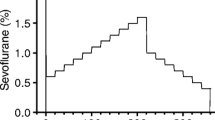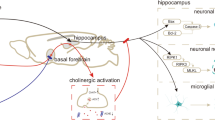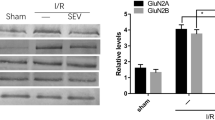Abstract
Purpose
Considerable evidence suggests that nitric oxide (NO) plays a role in synaptic transmission in the central and peripheral nervous systems. However, whether inhibition of NO synthesis decreases minimum alveolar concentration (MAC) of inhalational anesthetics is controversial. We examined the effects of 7-nitroindazole (7-NI), a selective inhibitor of neuronal NOS (nNOS), on the MAC of sevoflurane and cerebellar cyclic guanosine monophosphate (cGMP) levels in mice.
Methods
Sevoflurane MAC and cerebellar cGMP levels were determined in mice after acute intraperitoneal or weeklong gavage feeding of 7-NI. Sevoflurane MAC and cerebellar cGMP levels after chronic treatment were measured on days 1, 4, and 7 and were repeated after an acute intraperitoneal dose of nitrog-l-arginine methylester (l-NAME).
Results
Acute and chronic treatment with 7-NI decreased the sevoflurane MAC by 20%–30%. Reduction of cerebellar cGMP levels was greater after intraperitoneal administration of NOS inhibitors than after gavage feeding of 7-NI.
Conclusion
Acute or chronic selective inhibition of neuronal NOS decreases the sevoflurane MAC and cerebellar cGMP levels in mice. 7-NI permitted probing of the role of NO in perception of noxious stimuli.
Similar content being viewed by others
References
Meller ST, Gebhart GF (1993) Nitric oxide (NO) and nociceptive processing in the spinal cord. Pain 52:127–136
Garthwaite J (1991) Glutamate, nitric oxide and cell-cell signaling in the nervous system. Trends Neurosci 14:60–67
Vincent SR, Hope BT (1992) Neurons that say NO. Trends Neurosci 15:108–117
Marletta MA (1993) Nitric oxide synthase structure and mechanism. J Biol Chem 268:12231–12234
Lowenstein CJ, Snyder SH (1992) Nitric oxide, a novel biologic messenger. Cell 70:705–707
Moore PK, Oluyomi AO, Baggage RC, Wallace P, Hart SL (1991)l-Ng-Nitro arginine methyl ester exhibits antinociceptive activity in the mouse. Br J Pharmacol 102:198–202
Kant GJ, Muller TW, Lenox RH, Meyerhoff JL (1980) In vivo effects of pentobarbital and halothane anesthesia on levels of adenosine 3′,5′-monophosphate and guanosine 3′,5′-monophosphate in rat brain regions and pituitary. Biochem Pharmacol 29:1891–1896.
Vulliemoz Y, Verosky M, Alpert M, Triner L (1983) Effects of enflurane on cerebellar cGMP and on motor activity in the mouse. Br J Anaesth 55:79–84
Johns RA, Moscicki JC, DiFazio CA (1992) Nitric oxide synthase inhibitor dose-dependently and reversibly reduces the threshold for halothane anesthesia. Anesthesiology 77:779–784
Adachi T, Kurata J, Nakao S, Murakawa M, Shichino T, Shirakami G, Shinomura T, Mori K (1994) Nitric oxide synthase inhibitor does not reduce minimum alveolar concentration of halothane in rats. Anesth Analg 78:1154–1157
Ichinose F, Huang PL, Zapol WM (1995) Effects of targeted neuronal nitric oxide synthase gene disruption and nitrog-l-arginine methylester on the threshold for isoflurane anesthesia. Anesthesiology 83:101–108
Adachi T, Shinomura T, Nakano S, Kurata J, Murakawa M, Shichino T, Seo N, Mori K (1995) Chronic treatment with nitric oxide synthase (NOS) inhibitor profoundly reduces cerebellar NOS activity and cyclic guanosine monophosphate but does not modify minimum alveolar anesthetic concentration. Anesth Analg 81:862–865
Moor PK, Babbadge RC, Wallace P, Gaffen ZA, Hart SL (1993) 7-Nitro indazole, an inhibitor of nitric oxide synthase, exhibits ant-nociceptive activity in the mouse without increasing blood pressuro. Br J Pharmacol 108:296–297
Pajewski TN, DiFazio CA, Moscicki JC, Johns RA (1996) Nitric oxide synthase inhibitors, 7-nitro indazole and nitrog-l-arginine methyl ester, dose dependently reduce the threshold for isoflurance anesthesia. Anesthesiology 85:1111–1119
Koblin DD, Deady JE, Eger EI II (1982) Potencies of inhaled anesthetics and alcohol in mice selectively bred for resistance and susceptibility to nitrous oxide anesthesia. Anesthesiology 56:18–24
Deady JE, Koblin DD, Eger EI II, Heavner JE, D'Aoust B (1981) Anesthetic potencies and the unitary theory of narcosis. Anesth Analg 60:380–384
Koblin DD, Dong DE, Deady JE, Eger EI II (1980) Selective breeding alters murine resistance to nitrous oxide without alteration in synaptic membrane lipid composition. Anesthesiology 52:401–407
Wood PL (1991) Pharmacology of the second messenger, cyclic guanosine 3′,5′-monophosphate, in the cerebellum. Pharmacol Rev 43:1–25
Ikeda M, Matsui K, Ishihara Y, Morita I, Murota S, Yuasa T, Miyatake T (1994) Cerebellar nitirc oxide synthase, cGMP and motor function in two lines of cerebellar mutant mice, Staggerer and Wriggle Mouse Segami. Neurosci Lett 168:65–68.
Rampil IJ, Mason P, Singh H (1993) Anesthetic potency (MAC) is independent of forebrain structures in the rat. Anesthesiology 79:1244–1249
Rampil IJ (1994) Anesthetic potency is not altered after hypothermic spinal cord transection in rats. Anesthesiology 80:606–610
Lothe A, Li P, Tong C, Yoon Y, Bouaziz H, Detweiler DJ, Eisenach JC (1994) Spinal cholinergic alpha-2 adrenergic interactions in analgesia and hemodynamic control: role of muscarinic receptor subtypes and nitric oxide. J Pharmacol Exp Ther 270:1301–1306
Xu JY, Pieper GM, Tseng LF (1995) Activation of a NO-cyclic GMP system by NO donors potentiates beta-endorphin-induced antinociception in the mouse. Pain 63:377–383
Mackenzie GM, Rose S, Bland-Ward PA, Moore PK, Jenner P, Marsden CD (1994) Time course of inhibition of brain nitric oxide synthase by 7-nitro indazole. Neuroreport 5:1993–1996.
Author information
Authors and Affiliations
About this article
Cite this article
Mi, WD., Ichinose, F., Goto, T. et al. 7-Nitroindazole, a selective inhibitor of neuronal nitric oxide synthase: effect on sevoflurane MAC and cerebellar cyclic GMP in mice. J Anesth 12, 137–141 (1998). https://doi.org/10.1007/BF02480092
Accepted:
Issue Date:
DOI: https://doi.org/10.1007/BF02480092




